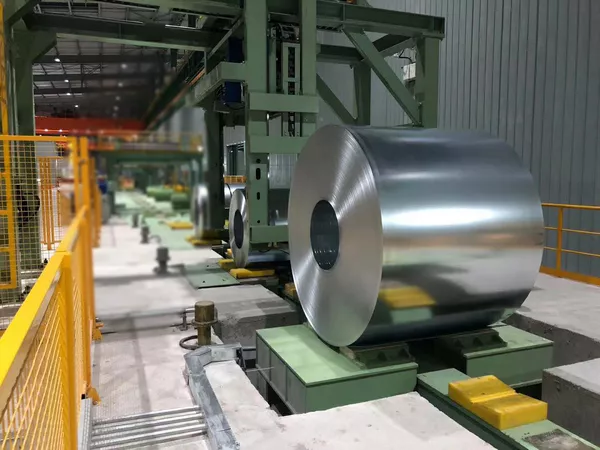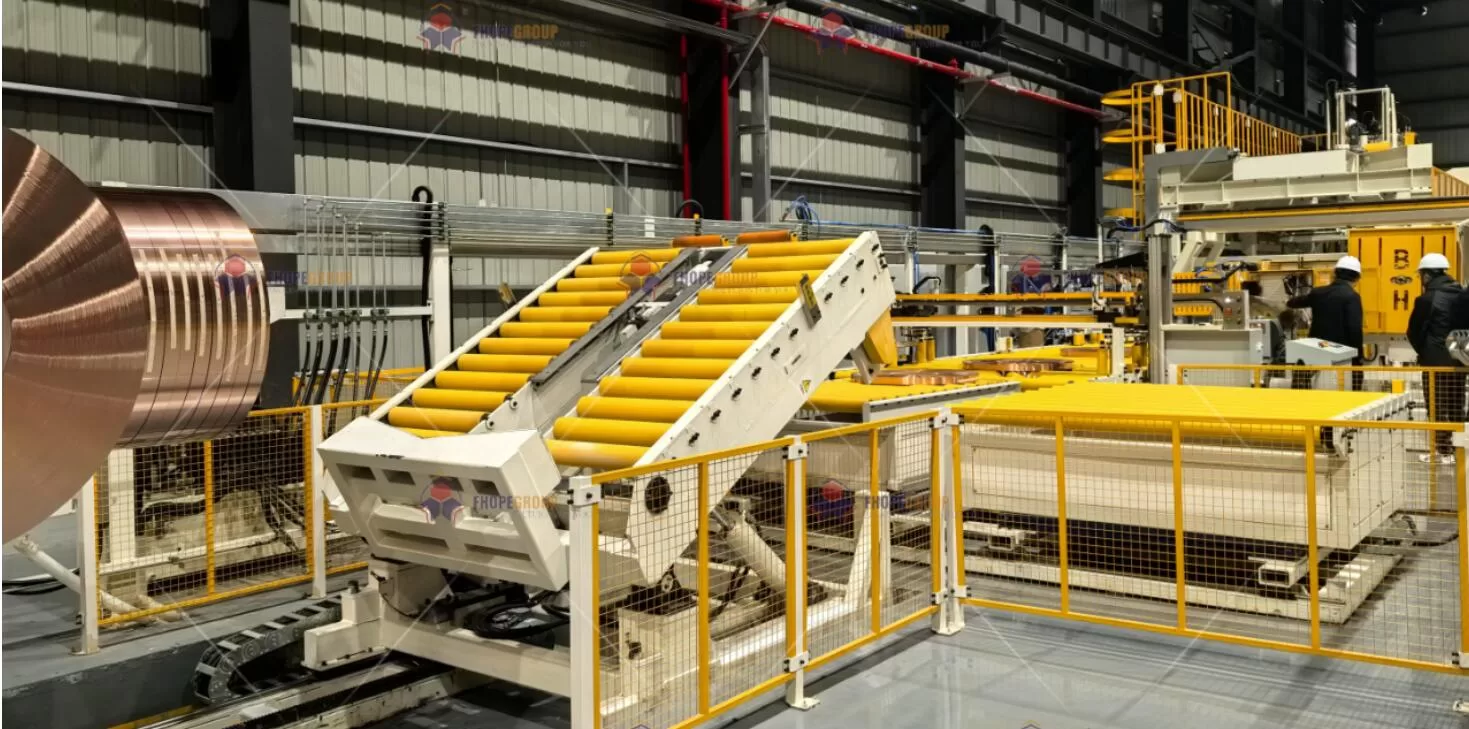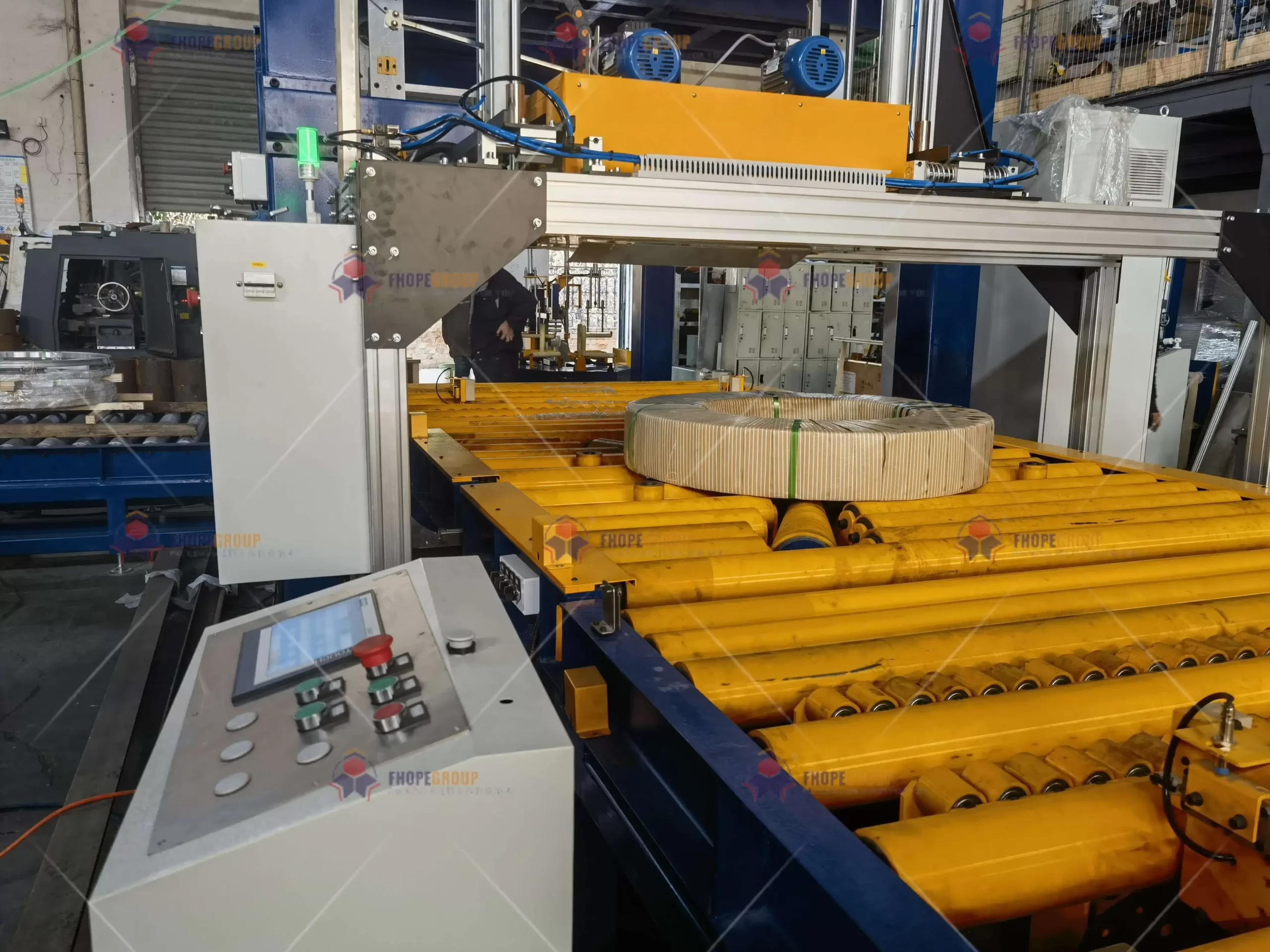Are you struggling to keep pace with the escalating demands of coil production while maintaining impeccable packaging quality? The bottleneck in your operation might not be slitting or coiling itself, but the outdated, inefficient coil packing process. It’s time to dissect the technical specifications of modern coil packing lines and understand what truly drives efficiency and profitability in today’s market.
Modern coil packing lines are no longer just about wrapping coils; they are sophisticated, automated systems engineered to enhance productivity, reduce material waste, ensure product integrity, and minimize labor costs. This breakdown explores the critical technical specifications that define a high-performance coil packing line, ensuring you’re equipped to make informed decisions for your operation.
This deep dive into the technical specifications will empower you to understand exactly what to look for in a cutting-edge coil packing solution. Let’s unpack the essential elements.
Designed for Versatile Production Needs: Adaptability is Key
In today’s dynamic manufacturing landscape, rigidity is a liability. Imagine a coil packing line that falters with every slight variation in coil dimension or material. Nightmarish, right? Modern coil packing lines are engineered for versatility, capable of handling a diverse array of coil sizes and packaging needs, ensuring seamless production flow regardless of product variations.
Modern coil packing lines are designed to accommodate a wide spectrum of coil dimensions, from delicate, narrow strips to hefty, wide coils, and various materials including steel, copper, and aluminum. They feature modular designs with easily adjustable components, allowing for quick changeovers and minimal downtime when switching between different coil types or packaging configurations. This adaptability ensures that manufacturers can efficiently process diverse product portfolios without compromising on speed or quality.

Dive Deeper into Customization: Tailoring the Line to Your Specific Needs
Beyond basic versatility, true adaptability lies in customization. A truly modern coil packing line isn’t a one-size-fits-all solution; it’s a system meticulously tailored to the nuances of your specific production environment. Let’s dissect the layers of customization that define a state-of-the-art coil packing line:
1. Modular Design for Scalability and Flexibility
Modularity is the cornerstone of customization. Lines built with modular components allow for:
- Scalability: Easily expand line capacity by adding modules as production volume increases.
- Flexibility: Reconfigure the line to accommodate new packaging requirements or changes in factory layout.
- Maintainability: Simplified maintenance and troubleshooting as modules can be individually accessed and serviced.
2. Adjustable Packaging Parameters: Precision at Your Fingertips
Customization extends to the core packaging functions:
- Wrapping Layers: Adjust the number of wrapping layers (stretch film, paper, etc.) to match the required protection level for different coil materials and storage conditions.
- Tension Control: Precisely control film tension to ensure secure packaging without damaging delicate coils or over-consuming materials.
- Sealing Methods: Adapt sealing parameters (heat sealing, gluing, strapping) based on packaging material and desired package integrity.
3. Material Handling Integration: Seamless Workflow
Customization isn’t limited to the packing station itself. Integration with upstream and downstream processes is crucial:
- Infeed Systems: Tailor infeed conveyors or coil handling mechanisms to seamlessly receive coils from slitters, rolling mills, or other production lines.
- Outfeed Systems: Customize outfeed conveyors or robotic arms for efficient transfer of packed coils to storage, warehousing, or shipping areas.
4. Data and Control Integration: Smart Factory Ready
Modern lines offer advanced data and control customization:
- PLC Integration: Seamlessly integrate with existing Plant-Level Control (PLC) systems for centralized data management and process control.
- Customizable Software: Adapt software interfaces and data logging to specific reporting needs and quality control protocols.
To illustrate the impact of customization, consider these varying needs and tailored solutions:
| Feature | Entry-Level Line | Mid-Range Line | High-End Line |
|---|---|---|---|
| Coil Types | Standard sizes, uniform materials | Varied sizes, mixed materials | Highly diverse sizes & materials, sensitive surfaces |
| Packaging | Basic stretch film wrapping | Multi-layer wrapping, moisture protection | Customized layers, corrosion protection, vacuum pack |
| Automation Level | Semi-automatic | Automatic with some manual adjustments | Fully automatic, minimal manual intervention |
| Integration | Standalone operation | Integrated infeed/outfeed conveyors | Full plant-level system integration, data analytics |
| Cost | Lower initial investment | Moderate investment, higher efficiency | Higher investment, maximum versatility & efficiency |
By understanding these layers of customization, manufacturers can move beyond generic solutions and invest in coil packing lines that are truly optimized for their unique production demands, ensuring both present efficiency and future adaptability.
Efficiency that Redefines Industry Standards: Automation at its Core
Manual coil packing: a labor-intensive, slow, and inconsistent process plagued by material waste and human error. In contrast, modern coil packing lines stand as beacons of efficiency, processing coils at speeds previously unimaginable, slashing material costs, and freeing up valuable labor for more strategic tasks.
Modern automated coil packing lines dramatically outperform manual methods, achieving throughput rates of 20-30 coils per hour, and in some high-speed configurations, even exceeding 30 coils per hour. This efficiency translates directly to increased production capacity, reduced lead times, and significant cost savings, making automated lines a cornerstone of competitive coil manufacturing.

Dive Deeper into Efficiency Metrics: Quantifying the Gains
Efficiency in coil packing lines isn’t just a buzzword; it’s a measurable set of metrics that directly impact your bottom line. Let’s dissect the key areas where automated lines excel:
1. Throughput and Cycle Time: Speeding Up Production
- Automated vs. Manual: Automated lines can pack 20-30+ coils per hour, compared to manual packing which typically manages just 1-2 coils per hour per operator.
- Reduced Cycle Time: Automated processes minimize handling times, wrapping times, and sealing times, leading to significantly faster overall cycle times per coil.
- Consistent Output: Automation ensures consistent cycle times, eliminating variability inherent in manual labor and allowing for predictable production schedules.
2. Material Optimization: Minimizing Waste, Maximizing Savings
- On-Demand Material Cutting: Automated lines cut wrapping materials (film, paper, strapping) precisely to coil dimensions, minimizing waste compared to pre-cut materials.
- Optimized Material Usage: Advanced sensors and controls ensure minimal material overlap and efficient wrapping patterns, reducing consumption per coil.
- Reduced Material Inventory: Lines using roll-fed materials reduce the need for storing various sizes of pre-cut packaging, saving space and inventory management costs.
3. Labor Cost Reduction: Reallocating Resources Strategically
- Reduced Operator Requirement: Automated lines require only 1-2 supervisors, compared to multiple operators needed for manual packing, significantly lowering labor costs.
- Reallocation of Labor: Freed-up labor can be redirected to higher-value tasks like quality control, machine maintenance, or upstream production processes.
- Minimized Labor Dependency: Automation reduces reliance on skilled manual labor, mitigating risks associated with labor shortages or inconsistencies in worker performance.
4. Energy Efficiency: Sustainable and Cost-Effective Operations
- Optimized Motor Control: Modern lines use energy-efficient motors and intelligent controls to minimize power consumption during operation.
- Reduced Material Waste (Indirect): By minimizing material waste, automated lines also indirectly reduce energy consumption associated with material production and disposal.
- Potential for Energy Recovery: Some advanced lines incorporate energy recovery systems to further enhance efficiency and reduce overall power consumption.
To illustrate the dramatic efficiency gains, consider this comparative data:
| Metric | Manual Packing | Automated Coil Packing Line | Improvement |
|---|---|---|---|
| Throughput (coils/hour) | 1-2 | 20-30+ | 10-15x Higher |
| Material Waste | 20-30% | 5-10% | 2-3x Reduction |
| Labor Cost per Coil | High | Low | Significant Reduction |
| Energy Consumption | Higher (indirect, material waste) | Lower (optimized processes) | Noticeable Reduction |
By focusing on these quantifiable efficiency metrics, manufacturers can objectively evaluate the transformative impact of modern coil packing lines and justify their investment in streamlined, high-output operations.
High-End Technology for Unparalleled Durability: Investing in Longevity
Coil packing lines operate in demanding industrial environments, facing heavy loads, continuous operation, and often harsh conditions. Therefore, durability isn’t just a desirable trait; it’s a fundamental requirement. Modern lines are built with high-end technology and robust materials, ensuring they withstand the rigors of production and deliver consistent performance for years to come.
Modern coil packing lines are engineered for longevity, utilizing heavy-gauge steel frames, wear-resistant components, and advanced technologies like PLC control systems and IoT-enabled monitoring. This robust construction and intelligent design minimize downtime, reduce maintenance, and extend the operational lifespan of the equipment, ensuring a sustained return on investment.

Dive Deeper into Technological Foundations: Building for the Long Haul
Durability in coil packing lines is not accidental; it’s the result of careful engineering and the strategic implementation of high-end technologies. Let’s dissect the core technological elements that contribute to the exceptional durability of modern lines:
1. Robust Construction Materials: Built to Last
- Heavy-Gauge Steel Frames: Frames constructed from heavy-gauge steel provide exceptional structural rigidity and resistance to deformation under heavy coil loads and continuous operation.
- Wear-Resistant Components: Key components like rollers, conveyors, and wrapping mechanisms are fabricated from hardened steel alloys or wear-resistant polymers, extending component lifespan and minimizing wear-related failures.
- Protective Coatings: Lines often incorporate protective coatings (powder coating, epoxy paint) to resist corrosion, abrasion, and chemical damage, ensuring durability in harsh industrial environments.
2. Advanced Control Systems: Intelligent Operation and Monitoring
- PLC Control Systems: Programmable Logic Controllers (PLCs) provide precise and reliable control over all line functions, minimizing errors and ensuring consistent operation over extended periods.
- Real-time Monitoring: Integrated sensors and IoT-enabled monitoring systems track performance metrics, detect potential issues early, and facilitate proactive maintenance, minimizing downtime.
- Diagnostic Capabilities: Advanced diagnostics built into control systems allow for rapid troubleshooting and fault identification, reducing downtime associated with repairs.
3. Key Technologies Driving Durability and Performance
Several specific technologies are central to the enhanced durability and performance of modern coil packing lines:
-
Through Eye Wrapping (TEW) Technology: This technology, pioneered by Pesmel (referenced in your source material), ensures superior moisture protection and package integrity compared to traditional folding methods. TEW technology creates an airtight package by wrapping coils through the eye with crepe paper and PE film, significantly extending storage time and product quality.
Feature TEW Technology Traditional Folding Method Package Airtightness Airtight Not airtight, VCI disappears Moisture Protection Superior Traditional, less effective Storing Time > 24 months < 6 months Material Recyclability Fully recyclable Laminated, less recyclable Operator Safety Operator safe, no VCI Operators involved with VCI Automation Automated, no operator involvement Manual/dangerous working phases -
Automated Body Wrapping: Automated body wrapping machines, also highlighted in your source material, provide robust mechanical protection. These systems optimize material usage by cutting materials to coil size directly from large rolls, reducing waste and material costs while ensuring consistent protection against handling, storage, and transportation damages.
Feature Automated Body Wrapping Traditional Pre-Cut Materials Material Optimization Optimized material consumption Pre-cut, potential for waste Material Inventory Minimized storage space Larger inventory, more space needed Cost Savings Reduced material costs by 30% Higher material costs Flexibility Adapts to different coil sizes Limited by pre-cut sizes Protection Uniformity Uniform, seamless coating Overlapping, potential gaps -
Automated Edge Protection: Integrated edge protection machines, again referenced in your materials, further enhance durability. These systems automatically apply edge protection tailored to coil dimensions, minimizing material waste and providing superior protection against edge damage during handling and transportation.
Feature Automated Edge Protection Manual Edge Protection Material Waste Minimized, optimized consumption Overlapping, 30% more waste Efficiency Automated, on-line formation Manually inserted, slower Protection Consistency Uniform, consistent application Variable, operator dependent Labor Requirement Minimal operator involvement Labor-intensive Outer Edge Protection Automatically inserted outer edge protection Manually inserted outer edge protection
By integrating these advanced technologies and employing robust construction principles, modern coil packing lines achieve unparalleled durability, ensuring reliable performance, reduced maintenance, and a long operational lifespan, maximizing your return on investment.
Cost Transparency and ROI: Understanding the Value Proposition
Investing in a modern coil packing line is a significant capital expenditure. However, viewing it solely as a cost overlooks the substantial return on investment (ROI) driven by increased efficiency, reduced operational expenses, and enhanced product value. Transparency in cost breakdown is paramount to accurately assess this ROI and make informed decisions.
A modern coil packing line, while representing an upfront investment ranging from $100,000 to $350,000, delivers a compelling ROI through reduced labor costs, minimized material waste, increased throughput, and enhanced product quality. This investment typically pays for itself within 12-18 months, transforming the packing process from a cost center into a profit driver.

Dive Deeper into Cost and Value: A Transparent ROI Analysis
Understanding the true value proposition of a modern coil packing line requires a deep dive into cost transparency and a comprehensive ROI analysis. Let’s break down the key components:
1. Transparent Cost Breakdown: No Hidden Surprises
Transparency starts with a clear understanding of all costs involved. A comprehensive cost analysis should encompass:
- Base Equipment Cost: The core cost of the coil packing line itself, clearly outlining included modules and features.
- Installation and Setup: Costs associated with equipment delivery, on-site assembly, system integration, and initial calibration.
- Maintenance and Support: Transparent pricing for preventative maintenance packages, extended warranties, and technical support services.
- Customization and Upgrades: Clearly defined costs for any tailored features, software modifications, or future upgrade options.
This transparent breakdown empowers you to assess the true investment and avoid hidden costs that can inflate the total expenditure unexpectedly.
2. Quantifying Return on Investment: Beyond the Initial Price Tag
ROI is the ultimate metric for evaluating any capital investment. For coil packing lines, ROI is driven by:
- Labor Cost Savings: Significant reduction in operator headcount translates directly to substantial labor cost savings, often the largest contributor to ROI.
- Material Cost Reduction: Optimized material usage and waste minimization lead to considerable savings on packaging material expenses.
- Increased Throughput and Capacity: Higher packing speeds and reduced downtime translate to increased production volume and revenue potential.
- Reduced Downtime Costs: Automated systems and proactive maintenance minimize downtime, preventing costly production interruptions and delays.
- Enhanced Product Value: Improved packaging quality and consistency enhance product presentation, reduce damage, and strengthen brand reputation, potentially increasing customer satisfaction and repeat business.
3. Comparative ROI Analysis: Manual vs. Automated
To illustrate the ROI difference, consider this comparative analysis:
| Metric | Manual Packaging | Automated Coil Packing Line | ROI Driver |
|---|---|---|---|
| Initial Investment | Lower | Higher | Initial Cost |
| Annual Labor Cost | $60,000 | $15,000 | Labor Savings |
| Annual Material Cost | $40,000 | $25,000 | Material Savings |
| Annual Downtime Cost | $20,000 | $5,000 | Downtime Reduction |
| Annual Operational Savings | N/A | $60,000 | Total Savings |
| ROI Recovery Period | N/A | 12-18 Months | Rapid ROI |
This data clearly demonstrates how the higher initial investment in an automated coil packing line is rapidly offset by substantial operational savings, delivering a compelling and quantifiable ROI within a relatively short timeframe.
4. Long-Term Value and Sustainable Savings: Beyond Year One
The benefits of a modern coil packing line extend far beyond the initial ROI recovery period:
- Sustained Cost Savings: Annual savings in labor, materials, and downtime continue to accrue year after year, generating long-term profitability.
- Increased Asset Value: A modern, efficient packing line enhances the overall value of your production facility.
- Competitive Advantage: Improved efficiency, quality, and responsiveness provide a significant competitive edge in the market.
- Sustainable Operations: Reduced material waste and optimized energy consumption contribute to more sustainable and environmentally responsible manufacturing practices.
By carefully evaluating cost transparency and conducting a comprehensive ROI analysis, manufacturers can confidently invest in modern coil packing lines, recognizing them not just as expenses, but as strategic assets that drive long-term value, efficiency, and profitability.
Conclusion
Investing in a modern coil packing line is a strategic imperative for coil manufacturers seeking to optimize their operations, enhance product quality, and achieve sustainable growth. By understanding the technical specifications breakdown, focusing on versatile design, embracing automation for efficiency, prioritizing durability through high-end technology, and demanding cost transparency for ROI confidence, you can make an informed decision that propels your production line into a new era of performance and profitability. Embrace the future of coil packing – your production line deserves nothing less than the best in power consumption specs.










